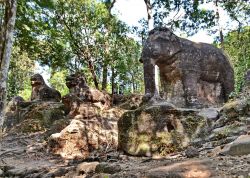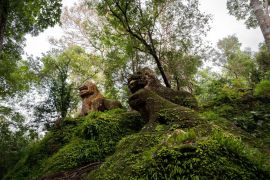Srah Damrei
| Native Name | ស្រះដំរី |
|---|---|
| BA# | C1713102 |
| CISARK# | 2001 |
| IK# | 558.01 |
| K Inscription | K.1327, K.1452 |
| Inscr. Location | In situ |
| Size | Medium |
| Condition | Intact |
| Type | Rock Carvings |
| Location | |
| Part of | Mahendraparvata |
| Village | Phum Thmei |
| Commune | Khnang Phnom |
| District | Svay Leu |
| Province | Siem Reap |
| Country | Cambodia |
| Coordinates | 13.50573, 104.12724 |
| History | |
| Founded | Late 8-early 9th Century (?) |
| Builder | (?) |
| Material | Sandstone - natural rock |
| Religion | Hinduism |
| UNESCO Proposed | 2020 |
| UNESCO Tentative | 2020 |

![]() Srah Damrei (ស្រះដំរី - Pronounced: Sras Dom-rei). A giant carved elephant, oversized frog and lions are the most recognisable of this collection of large, carved sandstone boulders which lies amid forest close to the southern edge of the Kulen escarpment. Formerly reached by a long hike, or tricky bike ride, through dense and heavily-mined secondary forest the site is today much more easily accessed. The bike track, passing by a signposted bat cave, has been cleared and widened while an alternative hiking route slightly to the east is another option. The former is a relatively easy 15-20-minute or so ride by motorbike but for the latter, we'd allow at least 1.30 minutes each way. Both routes begin a short distance east of Thmei village, on the route to Wat Preah Kral, and are signposted in English as well as Khmer.
Srah Damrei (ស្រះដំរី - Pronounced: Sras Dom-rei). A giant carved elephant, oversized frog and lions are the most recognisable of this collection of large, carved sandstone boulders which lies amid forest close to the southern edge of the Kulen escarpment. Formerly reached by a long hike, or tricky bike ride, through dense and heavily-mined secondary forest the site is today much more easily accessed. The bike track, passing by a signposted bat cave, has been cleared and widened while an alternative hiking route slightly to the east is another option. The former is a relatively easy 15-20-minute or so ride by motorbike but for the latter, we'd allow at least 1.30 minutes each way. Both routes begin a short distance east of Thmei village, on the route to Wat Preah Kral, and are signposted in English as well as Khmer.
2 small (usually dry) pools are situated close to the carvings while other (unconfirmed) figures are said to be found close by. There are several similar sites on Kulen and this is undoubtedly the most impressive. A tentative 9th-century date has been given to the statues but this is impossible to confirm.
Two inscriptions are recorded at this site, however one has a very peculiar origin. Inscription K.1327 can be found at the base of the carved stone lion, by its feet, which contains 2 lines of pre-Angkorean Khmer text. The second inscription K.1452 is a direct copy of K.1327, which only came to light sometime between 2010-2018 in photographs, is of a more recent time. Earlier explorers and researchers from the middle of the 20th century never mentioned any inscriptions on the large elephant statue, nor were there any mention by more modern archaeologists and researchers. Upon closer inspection of the elephants stomach, the area in which the inscription sits appear to be of a lighter nature, and with the combination of weathering and moss, it has made the inscription appear older than it is. [1]
Map Location
Image Gallery
If you would like to upload additional images to the gallery, please refer to the Upload Instructions guide
Historic Archive
A collection of historic photographs, artist sketches, maps etc. (Please ensure that anything you do upload is free of copyright and/or you have permission from the original photographer/artist/author to share)
Nearby Sites
- Kok Chen
- Kroes Prasat (Anlong Thom)
- Kroes Thma Bae Kream
- Mahendraparvata
- Peung Keo Nama
- Peung Menoi
- Peung Moha Eisei
- Peung Ta Sot
- Peung Thbal
- Prasat Bos Neak
- Prasat Chop
- Prasat Chrei (Kulen)
- Prasat Damrei Krap
- Prasat Kanhcha
- Prasat Khting Slap
- Prasat Koki (Kulen)
- Prasat O Pha-ong
- Prasat Peung Moha Eisei
- Prasat Rong Chen
- Prasat Thma Dap
- Preah Ko (Kulen)
- Rup Arak
- Srah Damrei
- Thnal Mrech
External Links
Links to additional resources such as articles, websites, videos etc.




